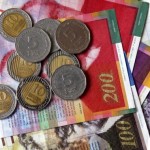Yesterday’s trade (in GMT terms) saw USD/CAD within the range of 1.2981-1.3133. The pair closed at 1.3060, shedding 0.40% compared to Mondays close. It has been the 134th drop in the past 292 trading days. The daily high has been a lower-high test of the high from July 11th. The major pair has increased its advance to 1.12% so far during the current month, following a 1.29% slump in June.
At 8:01 GMT today USD/CAD was edging up 0.11% on the day to trade at 1.3075. The pair touched a daily high at 1.3083 during mid-Asian trade, undershooting the daily R2 level, and a daily low at 1.3035 during the early phase of the Asian trading session.
Meanwhile, crude oil futures marked their 68th gain out of the past 147 trading days on July 12th. Oil for August delivery went up as high as $46.92 per barrel, or its highest level since July 7th, and closed at $46.46, soaring 3.80% compared to Monday’s close. As of 8:09 GMT today the commodity was edging down 0.43% to trade at $46.26, after going down as low as $46.09 per barrel earlier.
On Wednesday USD/CAD trading may be influenced by the following macroeconomic reports and other events as listed below.
Fundamentals
United States
Fed speakers
Markets will be paying attention to the statements by several Fed officials. At 10:00 GMT the Fed President for Philadelphia, Patrick Harker, is expected to speak, followed by the Fed President for Dallas, Robert Kaplan, at 13:00 GMT. Any remarks regarding the US economic outlook or the Banks monetary policy stance would certainly boost USD volatility.
Import and Export prices
Prices of imported goods in the United States probably rose for a fourth consecutive month in June, going up at a monthly rate of 0.5%, according to market expectations. In May import prices were 1.4% higher from a month ago, or marking their steepest rate of increase since March 2012, as imported fuel prices surged 16.2%, while non-fuel prices (consumer goods, foods and beverages, feeds, capital goods) rose 0.3%. In annual terms, import prices were 5.0% lower in May, which has been the 22nd consecutive month of decline. Generally, higher import prices of goods suggest higher rates of consumer inflation.
Prices of exported goods from the United States probably increased for a third straight month in June, going up at a monthly pace of 0.3%, according to market expectations. In May export prices rose 1.1% from a month ago, or marking their largest rate of increase since March 2011, as agricultural export prices surged 2.9%, supported by prices of soybeans, corn, meat and nuts. At the same time, non-agricultural export prices soared 1.0%, driven by higher prices of industrial supplies and materials, capital and consumer goods. In annual terms, export prices slumped 4.5% in May, or for a 21st month in a row. Lower prices of exported goods generally bolster demand abroad, and as US trade accounts for 20% of international trade relations, this also tends to be dollar positive.
The Department of Labor is expected to release the official numbers at 12:30 GMT.
Beige Book
At 18:00 GMT the Federal Reserve is to release its ”Beige Book” report. It is published eight times during the year. Each of the banks in the 12 Federal Reserve Districts gathers data in regard to current economic situation in the country on the basis of interviews with key business contacts, economists, market experts, and other sources. In case the Beige Book presents an optimistic economic outlook, this will usually support the US Dollar, while a pessimistic view will have a bearish effect on the currency.
Canada
BoC policy decision
Bank of Canada’s (BoC) Governing Council will probably leave the target for the benchmark interest rate (overnight rate) without change at 0.50% at the policy meeting today, according to market expectations. At its meeting on July 15th 2015 the central bank cut its benchmark by 0.25% to the current level, the Bank Rate was reduced to 0.75% from 1.00%, while the Deposit Rate was lowered to 0.25% from 0.50%.
At the May meeting all key rates were left intact, while inflation was seen as roughly in unison with forecasts and Q2 growth was expected to decelerate due to wildfires in Alberta.
According to excerpts from the BoC Statement from May 25th 2016: ”…the economy’s structural adjustment to the oil price shock continues, but is proving to be uneven. Growth in the first quarter of 2016 appears to be in line with the Bank’s April projection, although business investment and intentions remain disappointing. The second quarter will be much weaker than predicted because of the devastating Alberta wildfires. The Bank’s preliminary assessment is that fire-related destruction and the associated halt to oil production will cut about 1 1/4 percentage points off real GDP growth in the second quarter. The economy is expected to rebound in the third quarter, as oil production resumes and reconstruction begins. While the Canadian dollar has been fluctuating in response to shifting expectations of US monetary policy and higher oil prices, it is now close to the level assumed in April.”
”Total CPI inflation has risen recently, largely due to movements in gasoline prices, but remains slightly below the 2 per cent target. Measures of core inflation remain close to 2 per cent, reflecting the offsetting influences of past exchange rate depreciation and excess capacity.”
”Canada’s housing market continues to display strong regional divergences, reinforced by the complex adjustment underway in the economy. In this context, household vulnerabilities have moved higher. Meanwhile, the risks to the Bank’s inflation projection remain roughly balanced.”
The official policy decision is scheduled to be announced at 14:00 GMT, followed by a press conference with BoC Governor, Stephen Poloz, at 15:15 GMT.
Bond Yield Spread
The yield on Canada’s 2-year government bonds went as high as 0.515% on July 12th, or the highest level since July 5th (0.519%), after which it closed at 0.505% to add 3.2 basis points (0.032 percentage point) compared to July 11th.
Meanwhile, the yield on US 2-year government bonds climbed as high as 0.697% on July 12th, or the highest level since June 24th (0.755%), after which it fell to 0.693% at the close to add 3.6 basis points (0.036 percentage point) compared to July 11th.
The spread between 2-year US and 2-year Canadian bond yields, which reflects the flow of funds in a short term, widened to 0.188% on July 12th from 0.184% on July 11th. The July 12th yield spread has been the highest one since June 15th, when the difference was 0.192%.
Daily, Weekly and Monthly Pivot Levels
By employing the Camarilla calculation method, the daily levels of importance for USD/CAD are presented as follows:
R1 – 1.3074
R2 – 1.3088
R3 (Range Resistance – Sell) – 1.3102
R4 (Long Breakout) – 1.3144
R5 (Breakout Target 1) – 1.3192
R6 (Breakout Target 2) – 1.3213
S1 – 1.3046
S2 – 1.3032
S3 (Range Support – Buy) – 1.3018
S4 (Short Breakout) – 1.2976
S5 (Breakout Target 1) – 1.2928
S6 (Breakout Target 2) – 1.2907
By using the traditional method of calculation, the weekly levels of importance for USD/CAD are presented as follows:
Central Pivot Point – 1.2987
R1 – 1.3147
R2 – 1.3250
R3 – 1.3410
R4 – 1.3570
S1 – 1.2884
S2 – 1.2724
S3 – 1.2621
S4 – 1.2518
In monthly terms, for USD/CAD we have the following pivots:
Central Pivot Point – 1.2907
R1 – 1.3163
R2 – 1.3401
R3 – 1.3657
R4 – 1.3913
S1 – 1.2669
S2 – 1.2413
S3 – 1.2175
S4 – 1.1937





